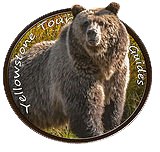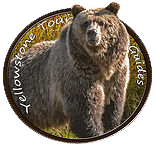Reopening’s Happening in Spring

Reopening’s Happening in Spring
Trips to Old Faithful will resume on 04/21/23! We are currently open with our Winter Wildlife Adventure with tours from Big Sky and Bozeman only. This trip travels via Bozeman and Livingston to the north side of the park and visits Mammoth Hot Springs, the Lamar Valley. This is the best area of the park for wildlife, and Mammoth is one of the most colorful thermal features in the park!
Mammoth Hot Springs
Mammoth Hot Springs is a geothermal area with an extensive mass of travertine terraces that have been created over thousands of years as calcium carbonate (CaCO3) dissolved in the water flows out as travertine. It is the largest known carbonate-depositing spring in the world. The mineral-rich water is superheated underground but cools as it comes to the surface, which allows carbon dioxide gas to escape, allowing calcium carbonate to be deposited in the water. This process is referred to as “travertine deposition.” There are many geothermal features to explore in Mammoth Hot Springs, and the best way to see them all is by walking the boardwalks. Upper Terrace Drive connects a series of springs and terraces over a 1.5-mile loop. The travertine terraces in Mammoth are continually changing in shape, color, and activity. As a result, you will likely find that some springs were active one to five years ago and are now dry and lifeless.
Lamar Valley
The Lamar Valley is a large wildlife habitat, and is known as “America’s Serengeti.” Here you can watch wolves, bison, grizzlies, elk, osprey, pronghorn, bears, deer, and coyotes roaming freely. When you get out of your car and start walking slowly, you increase your chances of spotting wildlife. It’s also helpful to be aware of the many pullouts that line the road, which make it easier to spot animals. If you’re in the mood to see wolves, it’s a good idea to have a backpacking checklist of what to bring with you. After all, it’s a lot more enjoyable to see them through binoculars or a scope rather than just looking at them in the distance. Wolves can be hard to spot without a scope and even if you do manage to spot them, it’s best to be careful when you’re close to the pack. They’re unpredictable and they may move in or out of view quickly. Always keep at least 25 yards between you and any animal and don’t approach any wildlife.
North Entrance
When the North Entrance reopens, visitors will once again be able to access some of the park’s top attractions like Mammoth Hot Springs, Blacktail Deer Plateau, Tower Falls and Dunraven Pass. The entrance and galleries were originally designed as part of a larger development at the north side of the Museum. These features include sculptures of crowns, lions’ heads and coats of arms of Edward VII.A Saluting Gallery above the North Entrance is a reminder of this grand scheme. The gallery also contains a sculptured group representing Liberty Enthroned guarded by Order and Authority. The Old Gardiner Road that connects Mammoth Hot Springs to the North Entrance in Gardiner, Montana, is expected to be a two-lane road by Oct. 15, with additional improvements continuing beyond that date, weather permitting.
Roosevelt Arch
Yellowstone National Park is home to many icons, from the iconic Gateway Arch at the Jefferson National Expansion Memorial to the awe-inspiring Roosevelt Arch in Gardiner. Each one is a proud symbol of the nation’s first national park, a place where visitors can experience nature in its purest form. The Roosevelt Arch at the North Entrance of Yellowstone is one of these symbols, a rusticated triumphal arch that was built to commemorate the opening of the park in 1903. It’s named after President Theodore Roosevelt, who attended the laying of the cornerstone and gave a speech from it. The original plans called for curved walls on either side of the arch that would surround a landscaped garden, two ponds and a waterfall. However, the region’s arid climate made this impossible, so the plan was shelved. Instead, the Roosevelt Arch now serves as a landmark on the North Entrance Road Historic District!
